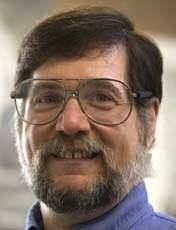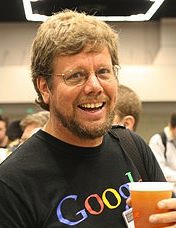These are the three persons responsible for the awesome robot simulator that we have.
 Richard Pattis – Designer of Karel
Richard Pattis – Designer of Karel
In 1981, Richard Pattis, then at Stanford, designed Karel, a world in which a little robot went about his business in a grid. At the time there was no computer simulation, no robot on the screen moving or making sounds; people learned Karel using paper and pencil. The idea was sound, though, and since then many people have used Karel to learn and teach programing. Presently Pattis teaches at U.C. Irvine. The name ‘Karel’ was Pattis’ homage to the writer Karel Čapek who, in 1920, in his play ‘R.U.R.’, used for the first time the word ‘robot’ to designate an artificial human-like being. R.U.R. are the initials of the name of the play: ‘Rossum’s Universal Robots’.
 Guido Van Rossum – Designer of Python
Guido Van Rossum – Designer of Python
Around 1990, Guido Van Rossum designed Python, a high-level interpreted language, written on top of C, that focuses on readability. Its strengths are interactivity, conciseness and the ease with which we can use it to translate ideas into programs; on the other hand, its weaknesses are efficiency and speed. Python is a general-purpose language, but it’s particularly well suited for string manipulation, scripting, task automation, front-ends, data analysis, prototyping, and as a first programming language. Python has consistently ranked among the 10 most popular computer languages for several years and was named ‘Language of the Year’ twice, in 2007 and 2010. Presently Van Rossum works at Dropbox.
 André Roberge – Designer of Reeborg
André Roberge – Designer of Reeborg
There are many simulators that implement the basic idea of Karel, reshaped to teach a myriad of languages. Most implementations of Karel have a flaw: either they do not give the user access to the underlying language, or they use a language that is not geared to beginners (or both). In 2004, André Roberge, a Canadian Physicist, addressed this issue: he wrote a version of Karel in Python, a language geared towards simplicity, in a way that Karel is simply an extension of the main language. The result was Rurple, and its online successor, Reeborg, that lives at reeborg.ca. Roberge named the robot in his online simulator ‘Reeborg’ but, in deference to Richard Pattis, we will refer to the robot as Karel, its original name. Presently Roberge is with the University of Sainté-Anne in Nova Scotia, Canada.